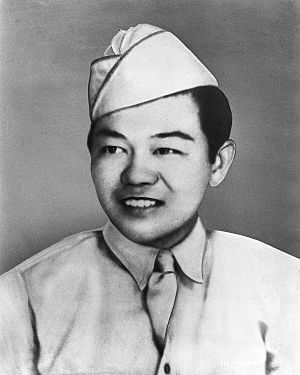Sadao Munemori facts for kids
Quick facts for kids
Sadao Munemori
|
|
|---|---|
 |
|
| Nickname(s) | Spud |
| Born | August 17, 1922 Los Angeles, California |
| Died | April 5, 1945 (aged 22) Killed in action at Seravezza, Italy |
| Place of burial |
Evergreen Cemetery, Los Angeles, California
|
| Allegiance | |
| Service/ |
|
| Years of service | 1942–1945 |
| Rank | |
| Unit | US Army 100th Infantry Battalion |
| Battles/wars | World War II |
| Awards | Medal of Honor |
Sadao Munemori (旨森 貞雄, August 17, 1922 – April 5, 1945) was a brave soldier in the United States Army. He was given the Medal of Honor after he died, which is the highest award a soldier can receive. Sadao sacrificed his own life to save his fellow soldiers during World War II in Seravezza, Italy.
He was a Private First Class in the 100th Infantry Battalion, which was part of the 442nd Regimental Combat Team. This team was special because it was made up almost entirely of Japanese American soldiers. Sadao Munemori was the only Japanese American to receive the Medal of Honor during or right after World War II for his amazing bravery.
Contents
Early Life
Sadao Munemori was born in Los Angeles, California. His parents, Kametaro and Nawa Munemori, had moved to America from Japan. Sadao was a Nisei, which means he was a second-generation Japanese American. He grew up in Glendale, a town near Los Angeles. He finished high school in 1940 and then became a car mechanic.
Joining the Army
Sadao volunteered to join the United States Army in November 1941. This was just one month before the Japanese attack on Pearl Harbor. He officially joined the army in February 1942.
After the attack on Pearl Harbor, things changed for Japanese American soldiers. Many were moved to different jobs and not allowed to train for combat. While Sadao was sent to army bases in the Midwest and South, his family was sent to a special camp called Manzanar. This was a difficult time for many Japanese American families.
In March 1943, Japanese American soldiers were allowed to return to active combat. Sadao volunteered to be part of the 442nd Regimental Combat Team. This unit was made up entirely of Japanese Americans. Many of the first soldiers in this unit came from Hawaii.
The 442nd fought bravely in Italy and France. Sadao was part of a famous mission to rescue a group of soldiers known as the "Lost Battalion." He continued to fight until he was killed in action at a place called the Gothic Line in Italy.
Years later, in the 1990s, awards given to soldiers in the 442nd were looked at again. It was found that some soldiers might have been overlooked because of unfair treatment. Because of this, twenty-one soldiers had their Distinguished Service Crosses changed to the Medal of Honor.
His Amazing Bravery
Sadao Munemori received the Medal of Honor for his incredible courage on April 5, 1945, in Italy. His unit was fighting near Seravezza and was stuck because of heavy enemy fire from a mountain defense. When his leader was hurt, Sadao took charge of his squad.
He bravely attacked two enemy machine guns by himself, throwing grenades. He then started to move back under heavy fire. As he was getting close to a shell crater where two of his friends were hiding, an unexploded grenade landed on his helmet and rolled towards his helpless comrades.
Without thinking, Sadao stood up into the dangerous gunfire. He dove onto the grenade, using his own body to block the explosion. By doing this, Private First Class Munemori saved the lives of his two friends. His heroic action also helped his company move forward and win the battle. He gave his life for his fellow soldiers.
Awards and Recognition
Sadao "Spud" Munemori received several important awards for his service during World War II:
- Combat Infantryman Badge
- Medal of Honor
- Bronze Star Medal
- Purple Heart
- Army Good Conduct Medal
- American Campaign Medal
- European-African-Middle Eastern Campaign Medal with seven campaign stars
- World War II Victory Medal
Remembering Sadao
Sadao Munemori is remembered in several ways:
- A highway interchange in Los Angeles is named the "Sadao S. Munemori Memorial Interchange."
- A U.S. Army troop ship was named the USNS Private Sadao S. Munemori.
- A building at the U.S. Army Reserve Center in West Los Angeles, California, is called Sadao S. Munemori Hall. It was dedicated in his honor in 1993.
- There is a statue of Sadao Munemori in Pietrasanto, Italy.
- An American Legion Post (a group for veterans) in Los Angeles is named after him.
See also

